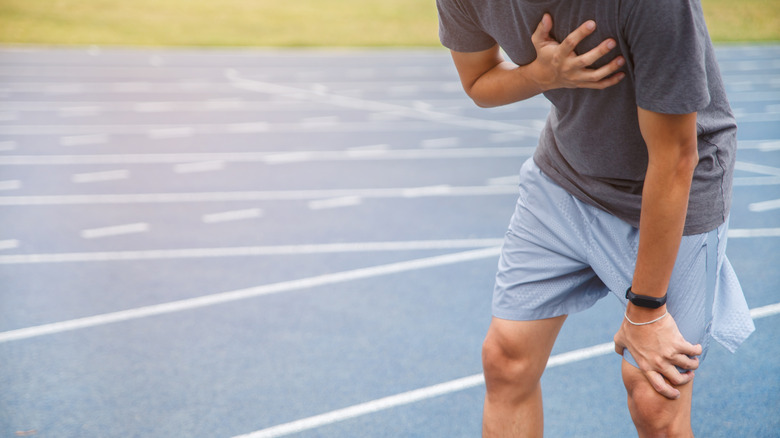The Real Reason Some People Are Allergic To Exercise
It happens to a fraction of the population. While running, biking or otherwise exerting themselves, a person develops an allergic reaction. Symptoms can be on the milder side, such as hives, or can be quite dangerous and potentially deadly, including anaphylaxis.
We've all been taught that exercise does a body good. And that's true of course, for the most part. But for the small group of people who develop exercise-induced anaphylaxis (EIA), exercise confuses the body and triggers an immune response. Just like in other allergies, the body produces antibodies — proteins in the blood that fight bacteria and foreign bodies — even though they're actually not needed, according to Health. These antibodies release several chemicals, one of which is histamine. The result is such symptoms as itchy skin, hives, angioedema (swelling beneath the skin), flushing, shortness of breath, wheezing, nausea, diarrhea, and headache.
There is one major difference, however, between EIA and other allergies. With allergens like peanuts, grass, or cat dander, a protein enters the body through the nose or mouth. But that doesn't happen with EIA, so technically it's not an actual allergy, Dr. Andrew Murphy, an allergist at Suburban Allergy Consultants in Pennsylvania, explained to Live Science.
Experts don't know, therefore, how exercise can cause an allergic reaction. What is known, however, is that EIA might only be triggered, in some cases, through a combination of exercise and eating a specific food. Read on for details.
When EIA becomes FDEIA
By itself, exercise can cause EIA, but for some people, it needs to be in conjunction with another allergen that is either ingested (or inhaled) for it to induce symptoms. This is called food-dependent exercise-induced anaphylaxis (FDEIA). Its prevalence is unknown, but it's been reported that it occurs in a third to half of all EIA cases, according to Health.
In FDEIA, a person eats a certain food, usually within three hours of working out, that alone doesn't cause any reaction, but combined with exertion, it leads to hives, wheezing, or more serious symptoms (via Business Insider). The most common foods to cause FDEIA are wheat, shellfish, tomatoes, peanuts, and corn, according to Medscape, but other possible triggers are fruits, seeds, milk, soy, lettuce, peas, beans, rice, and various meats.
In some instances, the cause can be any food eaten before a workout, or even an allergen that is inhaled, such as dust mite debris or mold spores. A reaction might also be exacerbated by alcohol, aspirin, OTC non-steroidal anti-inflammatory drugs, such as ibuprofen, or by exercising in very humid, hot or cold weather.
As with EIA, no one knows what causes FDEIA. There are theories, however. One is that exercise makes the digestive tract more permeable, allowing allergens to come into contact with the immune system, according to Live Science.
To prevent FDEIA from happening, it's recommended you avoid the offending food, if you can pinpoint it, in the six to eight hours before a workout.
Controlling EIA
There are no known risk factors for EIA, but some cases have been traced to heredity. In addition, two large studies have determined that it's twice as likely to happen in females than males. And it appears to be most common in the teens and twenties, according to Health. Overall fitness level doesn't appear to be related to risk.
In an individual exercise session, EIA is usually triggered by moderate-intensity to vigorous physical activity. To prevent symptoms, you can try reducing the intensity of your workout, but EIA can occur even with low-intensity activity. Swimming hasn't been associated with EIA, so you may consider taking your workout to the pool (per Business Insider).
Episodes of EIA aren't entirely predictable. Working out at the same intensity doing the same type of exercise won't necessarily trigger the same symptoms for you each time. But if you do experience EIA, see a doctor. She may recommend that you take an antihistamine like Zyrtec a half-hour before exercising and that you have an inhaler and/or Epi-Pen on hand. There are ways to prevent EIA, but unfortunately it can't be cured.



